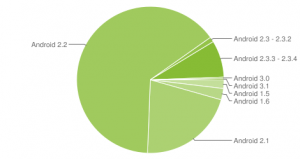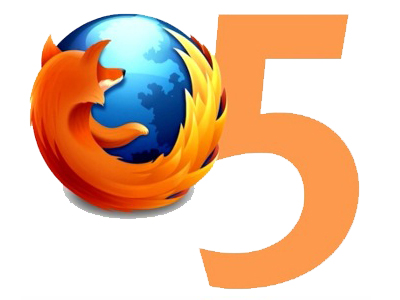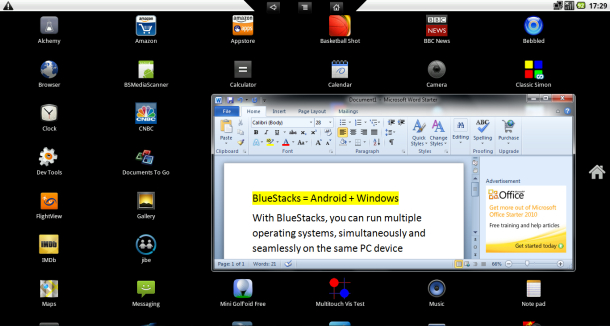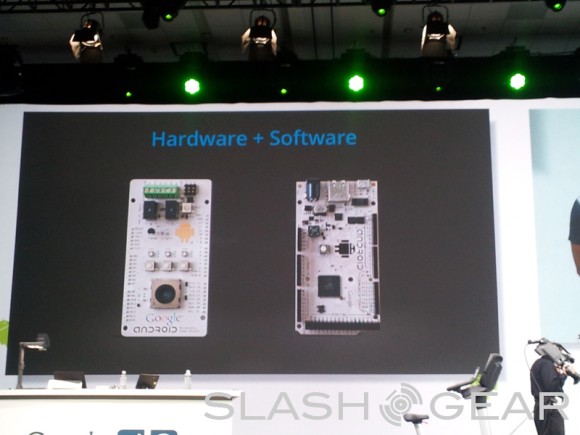Entries tagged as software
Sunday, July 17. 2011
Via Forbes
-----
HTML5 is a hot topic, which is a good thing. The problem is that
99% of what’s been written has been about HTML5 replacing Flash. Why is
that a problem? Because not only is it irrelevant, but also it prevents
you from seeing the big picture about interoperability.
But first things first. A few facts:
- You do not build a web site in Flash. The only way to build a
website is to use HTML pages, and then to embed Flash elements in them.
- Flash as been around for more than 12 years. It is a de facto
standard for the publishing industry. (No Flash = no advanced features
in banners).
- HTML5 does not officially exist (yet). Rather, it’s a specification in working draft, scheduled for publication in 2014.
- Less than half of installed browsers are HTML5 compliant, with different levels of compliance.
- The video element in HTML5 is perfect for basic video
players, but Flash and Silverlight are much more suitable for advanced
video feature (streaming, caption, interactive features and
miscellaneous video effects).
These are not interpretations or opinions. These are facts. The truth is writing about the agony of Flash is an easy way to draw readers,
a much easier way than to adopt a nuanced stance. And this is why we
read so many garbage about HTML5 vs. Flash. (For an accurate
description, please read HTML5 fundamentals).
All this said, HTML5 will indeed replace Flash in certain circumstances, specifically Light interface enhancements.
To explain this, we must go back in time: HTML’s specifications evolved
over 10 years, thus web developers wishing to offer an enhanced
experience had no choice but Flash. In recent years, we began to see
Flash used for custom fonts and transitions. But HTML has at last
evolved into HTML5 (and CSS3), which allow web designers to use custom
fonts, gradients, rounded corners and transitions, among other uses. So
in this particular case (light interface enhancements), Flash is rapidly
losing ground to a much more legitimate HTML5.
So if HTML5 is more suitable for light interface enhancements, this
leaves rooms for Flash to do what it does best: heavy interface
enhancements, vector-based animations, advanced video and audio
features, and immersive environments.
To make a long story short: Flash has a 10 years advance over
HTML. This technology isn’t better but because it’s owned by a single
company has the entire control on its innovation rate. I have
no doubt that one day HTML will have the same capabilities as Flash
today, but in how many years? Don’t mistake me. Not every site needs
Flash or an equivalent RIA technology: Amazon, Ebay and Wikipedia built their audiences with classic HTML, as did millions of web sites.
So for the sake of precision: I am not an Adobe ambassador nor I am a
web standards’ ayatollah. I am just a web enthusiast enjoying what the
web best has to offer, whether powered by standard or proprietary
technologies. Moreover, standardization is not a simple process, because
what we refer to as standards (from MP3 and JPEG to h.264) are in fact
technologies owned by private companies or consortiums.
Then, there is the mobile argument. If iOS and Android provide users
with an HTML5 compliant browser, what about Blackberry? Symbian? WebOS?
Feature phones? Low cost tablets? If interoperability and wider reach are mandatory, then maybe the better way to achieve them will be to focus on APIs exploited by multiple interfaces, rather than on a miraculously adaptive HMTL5 front-end.
Of course, there are many technical arguments for one technology over the other. But the best and most important part is that you don’t have to choose between HTML5 and Flash because you can use both.
Maybe the best answer is to acknowledge that HTML5 and Flash have their
pros and cons and that you can use one or the other or both depending
on the experience you wish to provide, your ROI and SEO constraints, and
the human resources you access.
In short, it’s not a zero sum game. Rather, it’s a process of natural
evolution, where HTML is catching up while Flash is focusing on
advanced features (and narrowing, even as it consolidates, its market
share). Both are complementary. So please, stop comparing.
Tuesday, July 12. 2011
Via OStatic
-----
 Mozilla has faced some backlash from IT administrators for its move to a rapid release cycle with the Firefox browser,
but you have to hand it to Mozilla for staying the course. For years,
Firefox saw upgrades arrive far less frequently than they arrove for
competitive browsers such as Google Chrome. Since announcing its new
rapid release cycle earlier this year,
Mozilla has released versions 4 and 5 of Firefox, and steadily gotten
better at ironing out short-term kinks, most of which have had to do
with extensions causing problems. Now, Firefox 8 is already being seen
in nightly builds, although it's not released in final form yet, and
early reports show it to be faster than current versions of Chrome
across many benchmarks. Mozilla has faced some backlash from IT administrators for its move to a rapid release cycle with the Firefox browser,
but you have to hand it to Mozilla for staying the course. For years,
Firefox saw upgrades arrive far less frequently than they arrove for
competitive browsers such as Google Chrome. Since announcing its new
rapid release cycle earlier this year,
Mozilla has released versions 4 and 5 of Firefox, and steadily gotten
better at ironing out short-term kinks, most of which have had to do
with extensions causing problems. Now, Firefox 8 is already being seen
in nightly builds, although it's not released in final form yet, and
early reports show it to be faster than current versions of Chrome
across many benchmarks.
Firefox 7 and 8 run a new graphics engine called Azure, which you can read more about here. And, in broad benchmark tests, ExtremeTech reports the following results:
"Firefox
8, which only just appeared on the Nightly channel, is already 20%
faster than Firefox 5 in almost every metric: start up, session
restore, first paint, JavaScript execution, and even 2D canvas and 3D
WebGL rendering. The memory footprint of Firefox 7 (and thus 8) has
also been drastically reduced, along with much-needed improvements to garbage collection."
Mozilla has already done extensive work on
how memory is handled in Firefox 7, and these issues are likely to be
addressed further with release 8. At this point, Chrome is Firefox's
biggest competition, and ExtremeTech also reports:
"While
comparison with other browsers has become a little passe in recent
months — they’re all so damn similar! — it’s worth noting that Firefox 8
is as fast or faster than the latest Dev Channel build of Chrome 14.
Chrome’s WebGL implementation is still faster, but with Azure,
Firefox’s 2D performance is actually better than Chrome. JavaScript performance is also virtually identical."
I
use Firefox and Chrome, but my primary reason for using Chrome is that
it has been faster. With the early glimpse of Firefox 8, the performance
gap stands a chance of being closed, and it looks like these two open
source browsers have never competed more closely than they do now.
Monday, July 11. 2011
Via ZDNet (By Steven J. Vaughan-Nichols)
-----
 I use Android every day both on my Droid II smartphone and my Barnes & Noble Nook Color e-reader/tablet. I like it a lot. But, I also have concerns about how it’s being developed and being presented to customers. I use Android every day both on my Droid II smartphone and my Barnes & Noble Nook Color e-reader/tablet. I like it a lot. But, I also have concerns about how it’s being developed and being presented to customers.
Before
jumping into why I think Android faces trouble in the long run, let me
mention one problem I don’t see as standing in Android’s way: The Oracle lawsuits Yes, Oracle claims that Google owes them billions in damages for using unlicensed Java technology in Android’s core Dalvik virtual machine.
I
follow patent lawsuits and here’s what going to happen with this one.
It will take years and millions of dollars in legal fees, but eventually
Google will either beat Oracle’s claims or pay them hefty licensing
fees. So, yes, one way or the other Google, and to a lesser extent
Oracle, will spend hundreds of millions on this matter before it’s done.
But, so what?
The mobile technology space is filled with patent
and licensing lawsuits. When I checked on these lawsuits in mid-October
there were dozens of them. Since then, Apple has sued Samsung; Dobly has sued RIM; and Lodsys, a patent troll, vs. Apple and all its iOS developers, By the time I finish writing this column someone will probably have sued someone else!
The
end-result of all this, besides lining the pockets of lawyers, is that
we’re all going to have pay more for our tablets and smartphones. It
doesn’t matter who wins or who loses. Thanks to the U.S.’s fouled up patent system, everyone who’s a customer, everyone who’s a developer, and everyone’s who in business to make something useful is the loser.
That said, here’s where Android is getting it wrong.
1. Too many developer versions
When Google first forked Android into two versions–The 2.x branch for smartphones and the 3.x for tablets–I didn’t like the idea. I like it even less now.
According to the Android Developers site, there are eight (8!) different versions of Android with market presence.
If we ignore the out-dated Android 1.5 and 1.6, that still leaves us
with six shipping versions that a developer needs to keep in mind when
he or she is creating or updating a program. In the case of the 2.x and
3.x lines that’s a lot of work. Oh, and yes there are now two versions
of 3.x: 3.0 and 3.1.

Currently used versions of Android.
Who can keep up with this? I couldn’t. But, wait there’s more!
2. Too many OEM versions
You’d
think that Android 2.2 on a Droid II would be the same on the Samsung
Galaxy Pro. You’d think wrong. Every original equipment manufacturer
(OEM) insists on tweaking the software and adding their own particular
programs to each phone. Sometimes, as James Kendrick points out, the same hardware doesn’t even work with Android on the exact same model.
Kendrick has found that the useless microSD card slot in the Motorola XOOM, even after its Android 3.1 update, still doesn’t work. Or, to be exact, it won’t work in the U.S. In Europe, XOOM users will get a fix that will let them use microSD cards.
Argh!
Here’s
a history lesson for Google and the rest of the movers and shakers of
Android. I’ve seen a “common” operating system used in this way before
during a technology boom. Once, it was with the pre-PC microcomputers.
They all ran CP/M-80, but every vendor had their own little tricks they
added to make their computers “better.” Then along came PC-DOS, soon to
be followed by MS-DOS, and all those companies-KayPro, Osborne, and
IMSAI-became answers in computer trivia games.
How did Microsoft
make its first step to becoming the Evil Empire? By delivering the same
blasted operating system on every PC. If users can’t count on using the
same programs and the same hardware accessories, like microSD cards, on
Android, they’re not going to stick with Android devices. If things
don’t get better with Android, who knows, maybe Windows 8 will have a shot on tablets after all!
3. Still not open enough
Google, for reasons that still elude me, decided not to open-source Android 3.x’s source code. This is so dumb!
I’m not talking about playing fast and loose with open-source
licenses or ethics-so Google really stuck its foot into a mess with this
move. No, I’m saying this is dumb because the whole practical point of
open source make development easier by sharing the code. Honeycomb’s
development depends now on a small number of Google and big OEM
developers. Of them, the OEM staffers will be spending their time making
Honeycomb, Android 3.0, work better with their specific hardware or
carrier. That doesn’t help anyone else.
4. Security Holes
This one really ticks me off. There is no reason for Android to be
insecure. In fact, in some ways it’s Not insecure. So why do you keep
reading about Android malware?
Here’s how it works. Or, rather, how it doesn’t work. Android itself,
based on Linux, is relatively secure. But, if you voluntary, albeit
unknowingly, install malware from the Android Market, your Android tablet or smartphone can’t stop you. Google must start checking “official” Android apps for malware.
Google has made some improvements to how it handles Android malware. It’s not enough.
So until things get better, if you’re going to download Android
programs by unknown developers, get an Android anti-virus program like Lookout. Heck, get it anyway; it’s only a matter of time until someone finds a way to add malware to brand-name programs.
5. Pricing
Seriously. What’s with Android tablet pricing?
Apple owns the high-end of tablets. If someone has the money, they’re
going to get an iPad 2. Deal with it. Apple’s the luxury brand.
Android’s hope is to be the affordable brand. So long as OEMs price
Android’s tablets at $500 and up, they’re not going to move. People will
buy a good $250 Android tablet, which is one reason why the Nook is selling well. They’re not buying $500 Android tablets.
Here’s what I see happening. Android will still prosper… right up to
the point where some other company comes out with an affordable platform
and a broad selection of compatible software and hardware. Maybe that
will be webOS, if HP drops the price on its TouchPads. Maybe it will be MeeGo.
Heck, it could even be Windows 8. What it won’t be though in the long
run, unless Android gets its act together, will be Android.
-----
Personal Comments:
In order to counteract a bit what is a kind of severe or pessimistic
view for Android's future, I would like to underline that Android has
to face major hardware evolution in a very short time. Duplicity of
hardware constructors that have jumped in the Android adventure has also
participated to version split. But as far as I have seen, it seems to
me that constructors are pretty fast in proposing to their customers upgrades
of their in-house Android versions, in order to stick to the very last
'official' Android version (the only one that all consumers expect to
have on their mobile device). For example, HTC has nicely managed this
while adding a very impressive GUI on the top of Android, that kind of
GUI that has hardly suggested that Android can be a real competitor to
iOS. So I do not see multiple Android versions as a negative point but
more as a rewarding one.
In
the same time Apple pushes users to upgrade their devices to the very
last iOS version without that much concern about user's wishes. When
compiling a program dedicated to Apple devices, you have to declare if
it is targeting iPhone/iPod and/or iPad with specifying a minimum
compatible version (because of core libraries evolution), which seems
very similar to me to handle kind of distinct versions of a similar
OS... thus being similar to what's occur at the Android OS level, but
may be in less 'democratic' way for the Apple's OS.
About
the points 3 and 4, I think this concerns absolutely every mobile OS,
and for some of them we may even not being aware about existing problems
or privacy issues (refer to GPS tracking issue on iPhone etc...).
Concerning the pricing, the ASUS eee Pad Transformer
is an excellent example to what we can expect about (affordable) prices
for mobile device based on Android OS. New mobile phones/tablets models are pretty expensive
mainly because they include very last chips (Tegra 2, Tegra 3, dual-core
CPU etc...). 6 months later the same 'top-level' device can be acquire
for one buck just by renewing a mobile network subscription.
Android OS is moving pretty fast in comparison to its direct competitors (on-screen widgets are typically something that is missing in the iOS), and MeeGo or Bada seems like just born dead OS. It sounds pretty clear that a ready to use and effective mobile OS
is much more easier to adopt for a hardware constructor than a brand
new one built in-house. It looks like much more an optimal solution to
invest effort in customizing Android OS like HTC did in a pretty
effective way than re-inventing the wheel.
The strength of Android is its community, which is just growing fast... very fast!
Wednesday, June 29. 2011
Via ReadWriteWeb
-----

Google launched an experimental tool called Swiffy in its Labs today, allowing developers to convert Flash (SWF) files to HTML5. That means you can reuse Flash content on devices without a Flash Player, even iPhone and iPads, explains Google on the project's Labs' page. And Swiffy's output works in all Webkit browsers, including Chrome and Safari.
The idea for the tool came from Google engineering intern Pieter Senster, who joined the mobile ad team last summer and later become a full time employee. Senster wanted to address the challenge of running Flash-like animations on non-Flash devices, specially for mobile ads.
Now, with Swiffy, that's possible. To use the program, you simply upload a SWF file and Swiffy returns HTML5 output. Swiffy is still in its early stages, though, so it won't convert all Flash content, only ads and simple animations for now.
-----
Swiffy
Tuesday, June 21. 2011
Via Slashgear
-----
Mozilla has just released Firefox 5 today after only a few short months since the previous version launched. The predecessor was deemed as the last major release version before Mozilla embarks on a Google Chrome model that will bring shorter faster release cycles.
Rather than having new features sit waiting for a major release, now
smaller bundles of new features will be pushed out as they become
ready, making for new releases as quick as every six weeks.

This latest update brings over 1000 new features for both desktop
and Android versions of the browser. Firefox 5 isn’t a major overhaul
outwardly, but does bring a lot of change under the hood that includes
performance and stability enhancements as well as privacy improvements
and new CSS animations and improved JavaScript support.
Performance wise, Firefox 5 uses new HTTP optimizations that
accelerates content and makes it much faster than before. The “Do not
track” option that was introduced in Firefox 4 is now more visible to
users and appears as an interface item for users to select whether or
not they want websites to track them. New CSS animations support will
allow for “Flash-like” dynamic content.
Friday, June 17. 2011
Via slashgear
-----
Microsoft has released the Kinect for Windows SDK beta, as expected,
allowing PC developers to use the motion-tracking accessory. A free
100MB download, the SDK offers support for the depth sensor, color
camera and quad-microphone array, along with all the clever
skeletal-tracking systems that Xbox 360 game developers have had access
to.

There’s also integration with Windows’ speech recognition API. That
potentially means developers will be able to use the microphone array –
which can pinpoint which user is talking thanks to beam formation – to
transcribe speech to text, open and control applications, and more.
Microsoft has thrown in plenty of technical documentation, samples,
all the drivers you’ll need and support for C++, C#, or Visual
Basic. This current iteration of the SDK is only for non-commercial
purposes; Microsoft says it will be releasing a commercial version
later on. You’ll obviously need a Kinect sensor, too, which currently
costs around $140.
----
Kinect for Windows SDK beta
Tuesday, June 14. 2011
Via Lambda the Ultimate
-----
This is sort of silly, but just plain cool. Eli Fox-Epstein encoded Rule 110 in HTML5 and CSS3. Rule 110 is Turing complete.
See one of his example tests on Github.
-----
Rule 110 (Stephen Wolfram)
Friday, June 03. 2011
Via Slashgear
-----
Peter Chou already unveiled HTCdev and the OpenSense SDK during his Uplinq 2011 appearance
yesterday, but the company has now fleshed out the details of the
developer-friendly proposal. Set to launch properly this coming summer,
HTCdev will offer developers guidance and tools to create apps for, and
modify, HTC smartphones. Meanwhile, the new SDK will allow for
integration with some of HTC’s custom tweaks to its range.
For instance, HTC had promised that third-party developers would be
able to code apps that take advantage of the digital stylus accompanying
the HTC Flyer,
and it’s the OpenSense SDK which will unlock the APIs for them to do
that. It will also allow them to use the 3D display as on the EVO 3D.
Right now, interested developers can sign up for more information at HTCdev.com ahead of both program and SDK going live in the next few months. The project follows HTCpro,
launched last year to offer mobile consulting and app development, and
comes on the heels of HTC’s announcement that, moving forward, it would
be unlocking the bootloaders on its Android phones.
Friday, May 27. 2011
Via cnet
-----
If you miss your
Android apps when using your PC, a start-up called BlueStacks says it has the answer.
Today, the company announced first-round funding of $7.6 million from
Ignition Ventures, Radar Partners, Helion Ventures, Redpoint Ventures,
and Andreessen Horowitz for its virtualization technology that provides a
foundation for Google's mobile operating system atop Windows. It's got
partnerships with Citrix for distribution to interested businesses and
with assorted as-yet unnamed PC makers for consumers.
"The idea is very simple," said Chief Executive and co-founder Rosen
Sharma, who previously was McAfee's chief technology officer. It started
when the 6-year-old daughter of another company co-founder was using
Android apps on his smartphone. "She went to a Netbook, and she wanted
the same apps on it," Sharma said. But it wasn't possible at the time.
"The number of people who want something like that is very, very large--both consumer and enterprise," Sharma said.
Consumers could be interested in having a Windows version of their
LinkedIn app for social and work connections, their sports app for
staying on top of the latest game results, or Pulse app for reading
news, Sharma said. And businesses are interested in extending the reach
of mobile apps they've created for their employees.
"A lot of people are doing their own apps" inside the company, Sharma
said. "The GM dealership app is an Android app. People who were doing
BlackBerry apps earlier are doing Android apps now."
The company, incorporated in 2008, plans to release a free beta version
of its software for people to download in June or July. It hasn't yet
set pricing for the final version, which is due to ship in the fourth
quarter. Partnerships with PC makers should be announced starting next
week, the company said.
Once people install the software, running an Android app is easy, Sharma
said. "From the user experience, it looks just like they're using an
app," he said.
Indeed, my CNET colleague Seth Rosenblatt found using Android apps on Windows with BlueStacks a seamless and effortless process.
BlueStacks uses Amazon.com's Android marketplace to distribute apps
because Google restricts its Android Market to specific ARM-based
devices.
User interface issues are one complication. Smartphone apps are designed
for a touch-screen interface and sometimes for a multitouch interface,
so some things won't work easily with a mouse and keyboard. Sharma
brushed the worry aside, though.
"We are seeing a lot of touch devices. In two years, a standard laptop
will have a touch screen," he said. In addition, trackpads on new
laptops support multitouch gestures such as pinching and zooming, he
said.
"That leaves very few apps that require absolute touch or multitouch,
like games," Sharma said. "The coverage you get is pretty large."
There are some caveats. Android today runs on the variety of ARM processors that are used in smartphones and
tablets,
but Windows machines--for now at least--use x86 chips from Intel or
Advanced Micro Devices. BlueStacks therefore runs its own build of the
OS from the open-source Android project.

The kind of high-powered apps you could run in Android include Microsoft Word and Adobe Photoshop. (Credit:
BlueStacks)
Another processor complication is that some Android programs--the
Firefox
and Opera browsers, for example--use the Native Developer Kit that
Google provides for software makers that want to write software that
runs directly on the processor rather than on Android's Java-like
software foundation. Those won't run on BlueStacks today.
But they will later.
"Most apps are cross-platform. But any app that uses native ARM code
will not run today," Sharma said. "We will enable those apps by
December."
Ultimately, BlueStacks expects to bridge the gap the other way, too,
letting Windows apps run on Android. That will work only on x86 versions
of Android, which currently aren't on the market.
Campbell, Calif.-based BlueStacks has only 20 employees now, and most
are in India where expenses are lower, so payroll costs won't drain the
bank account quickly. Instead, the company plans to use its VC money to
try to spread its software foundation as rapidly as possible.
"Our question is getting distribution," Sharma said. He expects to have
20 million copies distributed through computer makers and 60 million
through Citrix's software channel, he said.
"Our goal is by end of 2012 to have a ridiculous-looking distribution number. Then the game changes completely," Sharma said.
-----
Bluestacks
Tuesday, May 10. 2011
Via SlashGear
During today’s opening keynote for Google I/O, they touched on all the major topics that folks were anticipating including Android Ice Cream Sandwich, Google Music, and Google TV,
but they also added some unexpected developments. One of them being
their new Android Open Accessory initiative, that will allow developers
to create their own hardware accessories that can be controlled by
Android.

The Android Open Accessory system is built on open-source Arduino. It
will will allow externally accessories connect to an Android-powered
device via USB and eventually Bluetooth. This could essentially mean the
start of a whole slew of “Made for Android” devices such as docks,
speakers, or even an exercise bike. This opens up a whole world of
possibilities now for external accessories to work with Android.
Google is offering an Android Device Kit or ADK for developers. The
kit comes with a sample implementation in the form of a USB accessory
along with all the hardware design files, the code for the accessory’s
firmware, and the Android application that interacts with the accessory.
---
Android Open Accessory Development Kit
|
 Mozilla has faced some backlash from IT administrators for its move to a rapid release cycle with the Firefox browser,
but you have to hand it to Mozilla for staying the course. For years,
Firefox saw upgrades arrive far less frequently than they arrove for
competitive browsers such as Google Chrome. Since announcing its new
rapid release cycle earlier this year,
Mozilla has released versions 4 and 5 of Firefox, and steadily gotten
better at ironing out short-term kinks, most of which have had to do
with extensions causing problems. Now, Firefox 8 is already being seen
in nightly builds, although it's not released in final form yet, and
early reports show it to be faster than current versions of Chrome
across many benchmarks.
Mozilla has faced some backlash from IT administrators for its move to a rapid release cycle with the Firefox browser,
but you have to hand it to Mozilla for staying the course. For years,
Firefox saw upgrades arrive far less frequently than they arrove for
competitive browsers such as Google Chrome. Since announcing its new
rapid release cycle earlier this year,
Mozilla has released versions 4 and 5 of Firefox, and steadily gotten
better at ironing out short-term kinks, most of which have had to do
with extensions causing problems. Now, Firefox 8 is already being seen
in nightly builds, although it's not released in final form yet, and
early reports show it to be faster than current versions of Chrome
across many benchmarks.
 I use
I use 





